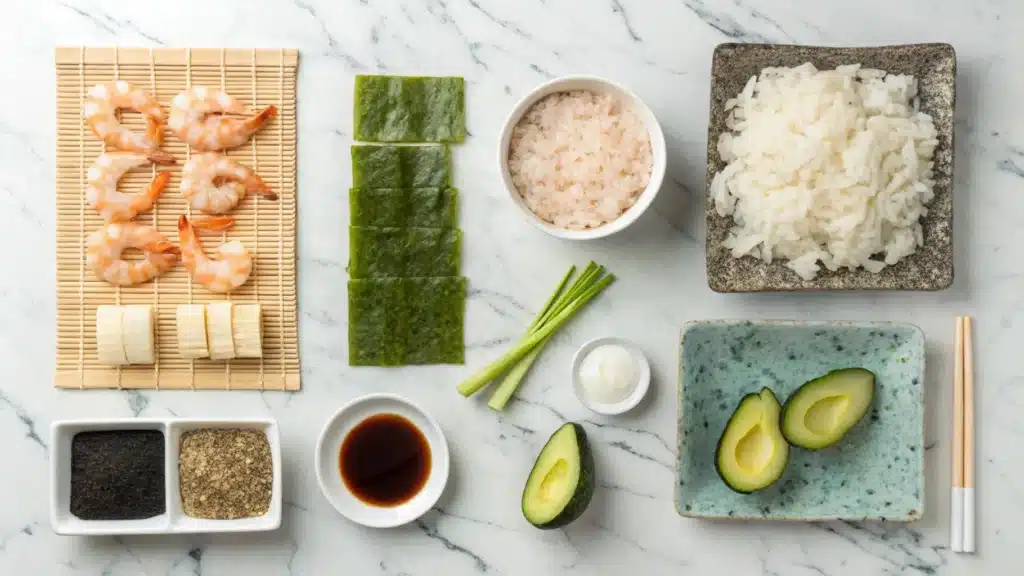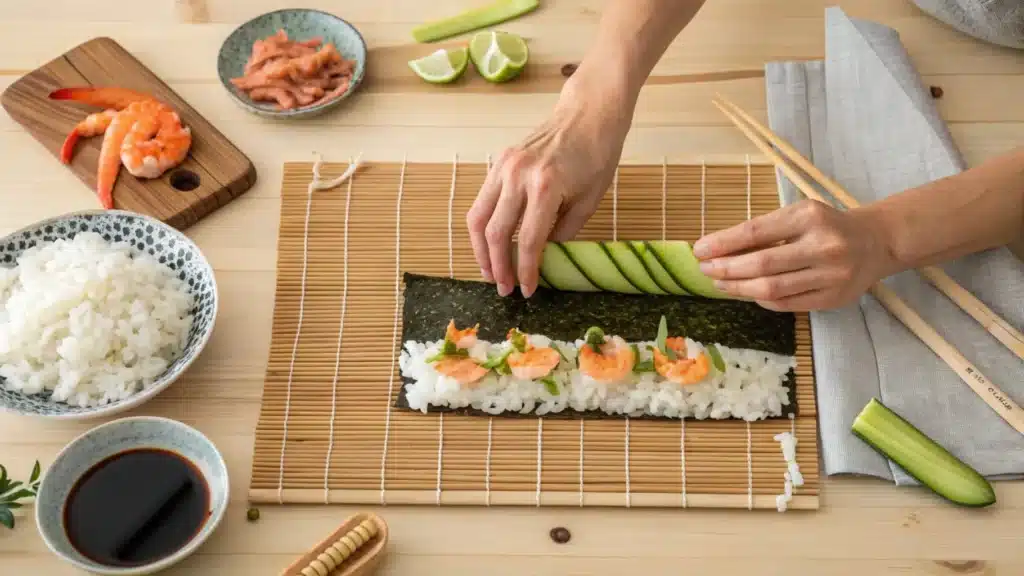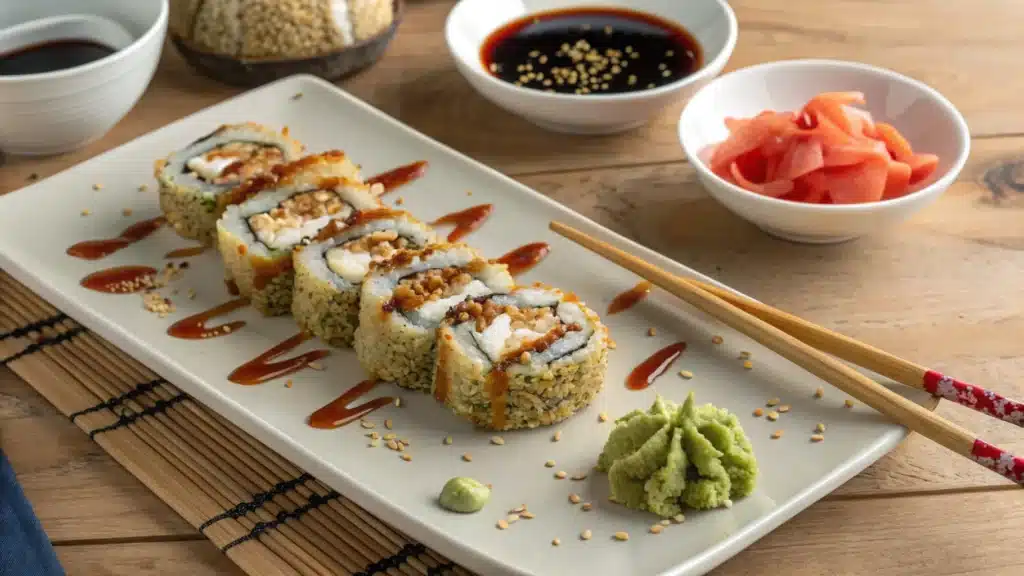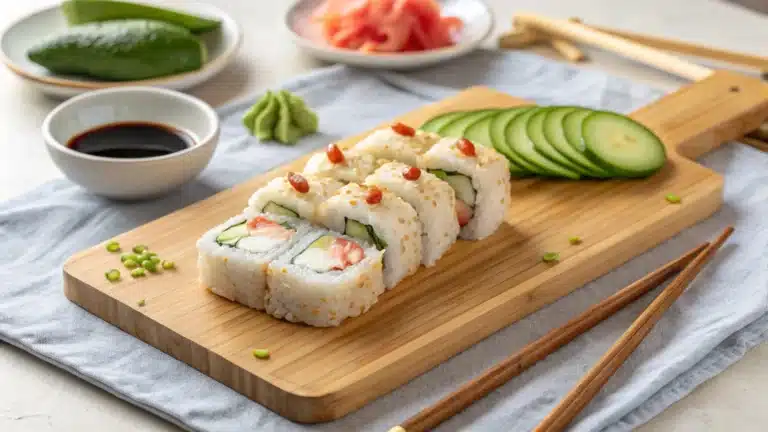Tempura rolls are a delightful blend of traditional Japanese sushi and crispy tempura goodness, making them a favorite among sushi lovers worldwide. From shrimp to chicken to vegetarian options, tempura rolls offer a versatile culinary experience. This article dives into what a tempura roll has in it, covering everything from its core components to popular variations and regional adaptations. Whether you’re a sushi aficionado or a curious diner, this guide unveils the secrets behind the irresistible appeal of tempura rolls.
Table of contents
The Basics of Tempura Rolls
What is a Tempura Roll?
At its core, a tempura roll is a fusion of two culinary staples: tempura and sushi. Originating in Japan, tempura—a method of deep-frying seafood or vegetables in a light, crispy batter—was introduced by Portuguese missionaries in the 16th century. Over time, it merged seamlessly with sushi, resulting in the iconic tempura roll.
Tempura rolls stand out for their unique texture and flavor combination. The crunch of the fried tempura contrasts beautifully with the soft sushi rice and the slight chewiness of nori (seaweed). Unlike traditional sushi, which typically focuses on raw fish, tempura rolls embrace cooked ingredients, making them an excellent choice for those new to sushi.
Core Components of a Tempura Roll
A tempura roll typically includes three primary elements: tempura, sushi rice, and nori. These components are further enhanced with a variety of fillings and toppings, depending on the type of roll.
- Tempura: The star of the show, often made with shrimp, chicken, or vegetables, coated in a light batter and fried until golden.
- Sushi Rice: Short-grain Japanese rice seasoned with a mixture of vinegar, sugar, and salt, lending a subtly tangy flavor.
- Nori: A sheet of seaweed that holds the roll together, adding a hint of umami.
Beyond these basics, many tempura rolls feature flavorful additions like cucumber, avocado, or spicy mayonnaise, elevating the taste profile. It’s this versatility that makes tempura rolls a popular choice at sushi restaurants worldwide.
In this section, we’ve established the fundamentals of tempura rolls, setting the stage for a deeper dive into their variations and unique ingredients. Up next, we’ll uncover what makes popular tempura rolls like shrimp and chicken varieties so special.
Ingredients Inside Popular Tempura Rolls
Shrimp Tempura Roll
When it comes to tempura rolls, shrimp is undoubtedly the most popular choice. The crispy, golden-brown shrimp tempura at the heart of this roll provides a delightful crunch with every bite. But what does a tempura roll have in it when shrimp is the main star? The answer lies in the complementary ingredients that enhance its flavor.
A classic shrimp tempura roll often includes:
- Shrimp Tempura: Lightly battered and deep-fried to perfection, the shrimp brings a savory, crispy texture.
- Cucumber: Thin slices of cucumber add a refreshing crunch, balancing the richness of the tempura.
- Avocado: Creamy avocado provides a smooth contrast, creating a well-rounded flavor profile.
- Sushi Rice and Nori: These staples hold the roll together, with the rice’s subtle tang enhancing the overall taste.
To elevate the experience, sushi chefs frequently drizzle spicy mayonnaise or eel sauce over the roll, giving it a tangy or sweet finish.

Chicken Tempura Roll
The chicken tempura roll is a fantastic alternative for those who prefer land-based protein. So, what does a tempura roll have in it when chicken takes center stage? This roll follows a similar formula to shrimp tempura rolls but swaps seafood for tender chicken.
Ingredients in a chicken tempura roll often include:
- Chicken Tempura: Juicy chicken strips are battered and fried until golden, offering a hearty base.
- Carrot or Bell Pepper: These vegetables introduce subtle sweetness and crunch.
- Lettuce or Cabbage: A fresh layer of greens adds texture and lightness.
Chicken tempura rolls are often paired with teriyaki sauce, which complements the savory chicken with a hint of sweetness.
Vegetable Tempura Roll
For vegetarians or those seeking a lighter option, the vegetable tempura roll is a satisfying choice. What does a tempura roll have in it when it’s all about veggies? The ingredients vary widely, but some staples include:
- Sweet Potato Tempura: This adds a touch of natural sweetness.
- Asparagus or Zucchini: Both contribute a satisfying crunch and mild flavor.
- Seasonal Vegetables: Ingredients like pumpkin, eggplant, or green beans may also appear.
This roll is often paired with soy sauce or a light dipping sauce, keeping the focus on the fresh vegetable flavors.
Crafting the Perfect Tempura Batter
What Goes into the Batter?
Tempura batter is the unsung hero of any tempura roll, creating the crispy, golden crust we all love. But what does a tempura roll have in it when you focus on the batter? Traditionally, tempura batter is made with:
- Flour: All-purpose or tempura-specific flour for a light, airy texture.
- Ice-Cold Water: Essential for maintaining the batter’s crispiness during frying.
- Eggs: These add richness and help bind the mixture together.
The secret lies in mixing the batter just enough to combine the ingredients. Overmixing can lead to a dense crust instead of the light, crispy texture tempura is known for.
Cooking Techniques for Tempura Perfection
To achieve the perfect tempura, precise frying techniques are key. Here are some tips:
- Temperature Control: The oil should be kept at a steady 350–375°F for even frying.
- Quick Frying: Tempura cooks quickly, so it’s best to fry in small batches to avoid crowding the pan.
- Draining Excess Oil: Once fried, place tempura on paper towels or a wire rack to remove excess oil and keep it crispy.
The batter and frying process are what transform simple ingredients into a crunchy delight. Whether you’re making shrimp, chicken, or vegetable tempura, a well-prepared batter ensures every bite is irresistible.
Variations in Tempura Rolls Across Regions
Japanese vs. Western Interpretations
Tempura rolls have taken on unique identities across regions, blending traditional Japanese roots with modern Western creativity. In Japan, tempura rolls stay true to their origins, focusing on fresh, high-quality seafood and vegetables, lightly fried in a delicate batter. These rolls often feature minimalist ingredients, emphasizing simplicity and natural flavors.
Meanwhile, Western adaptations often bring bold, innovative twists. What does a tempura roll have in it in Western cuisine? It might include ingredients like cream cheese, spicy mayo, or even tropical fruits like mango. These additions create rolls that are rich and indulgent, catering to adventurous palates.
Specialty Tempura Rolls from Sushi Restaurants
Every sushi restaurant seems to have its signature tempura roll. Some popular variations include:
- Dragon Roll: A shrimp tempura roll topped with avocado slices, eel sauce, and tobiko (fish roe).
- Volcano Roll: Featuring spicy mayo and baked seafood layered over a vegetable tempura roll.
- Rainbow Roll: Combining tempura with a colorful assortment of raw fish and avocado on top.
Each specialty roll showcases the versatility of tempura, making it an exciting menu option for sushi lovers.
For a recipe inspired by one of these variations, visit this Chicken Tempura Roll Recipe.
Health Considerations of Tempura Rolls
Are Tempura Rolls a Healthy Option?
When it comes to sushi, tempura rolls are undeniably delicious, but they may not be the healthiest choice. What does a tempura roll have in it that makes people question its health benefits? The answer lies primarily in the tempura batter, which adds calories and fat due to the frying process. Compared to raw fish sushi, tempura rolls are heavier and higher in calories.
That said, there are plenty of reasons why tempura rolls can still be part of a balanced diet. For instance, they often contain nutrient-rich ingredients like fresh vegetables, avocado, and seafood. While the batter contributes to the calorie count, the vegetables and seafood provide vitamins, minerals, and omega-3 fatty acids, which are essential for good health.
Moreover, you can make healthier choices when eating tempura rolls. Pairing them with a light side dish, such as miso soup or a cucumber salad, helps balance the meal while adding hydration and fiber. Additionally, choosing rolls with vegetable tempura instead of fried shrimp can significantly reduce calories without compromising on flavor.
Tips for Making Healthier Tempura Rolls
To enjoy tempura rolls guilt-free, consider these suggestions:
- Use a thinner batter: A lighter coating decreases calorie intake while keeping the crunch intact.
- Switch to brown rice: Brown rice adds fiber and improves the overall nutrition of the roll.
- Opt for vegetable-based fillings: Sweet potatoes, zucchini, and asparagus are lower in calories yet high in flavor.
By being mindful of your choices, you can enjoy tempura rolls as part of a varied, healthy lifestyle. Balance and moderation are key!
How to Make Tempura Rolls at Home
Ingredients for Homemade Tempura Rolls
Making tempura rolls at home might seem intimidating at first; however, it’s surprisingly straightforward once you know the basics. What does a tempura roll have in it when you prepare it from scratch? Here’s what you’ll need:
- Tempura batter mix: You can buy it pre-made or create your own with flour, ice-cold water, and eggs.
- Fillings: Shrimp, chicken, or vegetables like cucumber, avocado, and carrots are all popular options.
- Sushi rice: Short-grain rice is essential for achieving the right texture and flavor.
- Nori sheets: These are the edible seaweed wraps that hold the roll together.
- Optional toppings: Spicy mayo, sesame seeds, or eel sauce for added flavor.
Step-by-Step Process
- Prepare the Tempura: First, coat your chosen ingredient in the tempura batter and fry it until golden. Then, let the tempura cool slightly to prevent it from wilting the nori.
- Cook the Sushi Rice: While the tempura cools, prepare the rice. Follow the package instructions and season it with a mixture of rice vinegar, sugar, and salt for an authentic sushi flavor.
- Assemble the Roll: After the rice is ready, lay a sheet of nori on a bamboo rolling mat with the shiny side down. Spread a thin, even layer of rice on the nori, leaving a small strip uncovered at the top. Next, add your tempura and any additional fillings.
- Roll and Seal: Using the bamboo mat, roll the sushi tightly. Seal the edge with a dab of water to keep the roll intact.
- Slice and Garnish: Finally, slice the roll into bite-sized pieces using a sharp knife. Garnish with your preferred toppings, such as sesame seeds or spicy mayo, and enjoy your homemade creation!

By preparing tempura rolls at home, you gain control over the ingredients, making it easier to adjust them to your preferences or dietary needs. Whether you stick to traditional shrimp tempura or experiment with creative combinations, the results are sure to impress. For more sushi ideas, check out the Salmon Avocado Roll Recipe to expand your sushi-making repertoire.
FAQs
What is in a tempura roll sushi?
A tempura roll sushi typically contains tempura (fried seafood or vegetables), sushi rice, and nori. Additional fillings like avocado, cucumber, or spicy mayo are common, depending on the type of roll.
What does tempura include?
Tempura includes ingredients coated in a light batter made from flour, water, and eggs, then deep-fried to create a crispy texture. Popular choices for tempura include shrimp, chicken, sweet potatoes, and asparagus.
Is tempura sushi unhealthy?
While tempura sushi is delicious, it is higher in calories than traditional sushi due to the frying process. However, you can balance it by pairing it with lighter dishes or opting for vegetable tempura rolls.
Do tempura rolls have raw fish?
Not always! Tempura rolls are a great choice for those who prefer cooked ingredients. Many rolls use fried shrimp, chicken, or vegetables, making them more approachable for beginners.
For more delicious sushi recipes, discover the Salmon Avocado Roll Recipe for another flavorful option!


